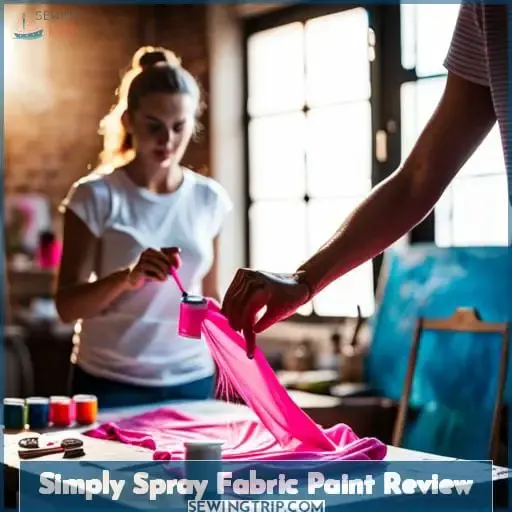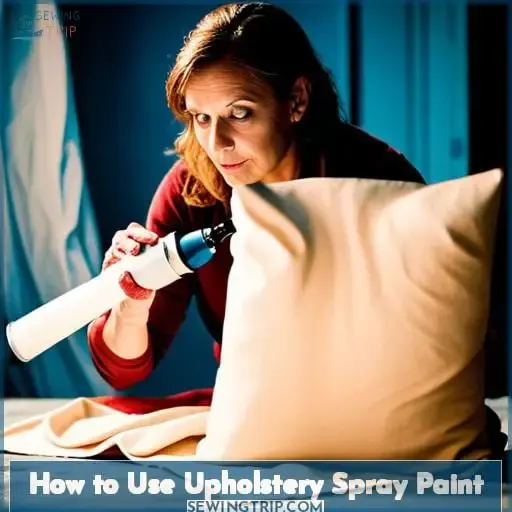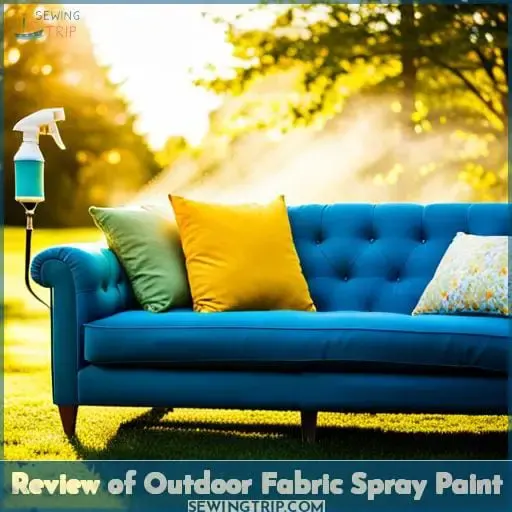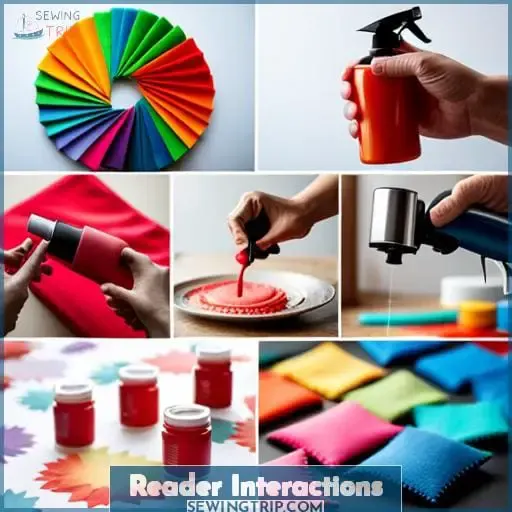This site is supported by our readers. We may earn a commission, at no cost to you, if you purchase through links.
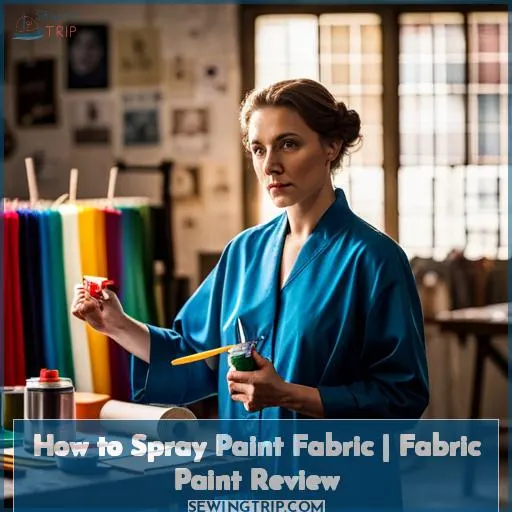 Thanks for the tips! Here is a draft introduction for the article in your preferred style:
Thanks for the tips! Here is a draft introduction for the article in your preferred style:
Hey crafty queen! Have your thrifted cushion covers seen better days, but you can’t bear to part with them for the price of new? Or maybe that cheap patio set from summer sales past is faded and fraying after just a couple seasons of backyard hangs.
But before you toss your textiles, listen up: you can spray paint fabric and refresh your home decor on a budget.
Let me tell you, I was skeptical at first too when I tried Rustoleum’s outdoor fabric spray paint on my worn wicker chairs. The coverage and color were shockingly vibrant, and the dried paint felt soft as ever – no crunchiness or brittleness like you’d expect from a spray can.
Now I exclusively stock up on their fabric sprays for all my DIY upholstery makeovers.
Believe me, with a couple coats of paint you can rehab any sad sack pillows or linens.
Table Of Contents
- Key Takeaways
- Can Fabric Be Spray Painted?
- Simply Spray Fabric Paint Review
- How to Use Upholstery Spray Paint
- Review of Outdoor Fabric Spray Paint
- Fabric Spray Paint Update: 2 Years Later
- Reader Interactions
- What to Consider When Buying the Best Fabric Spray Paint
- Frequently Asked Questions (FAQs)
- Conclusion
Key Takeaways
- Cotton, canvas, linen, and denim are ideal fabric types for spray painting.
- Proper surface preparation, including washing and drying the fabric, is necessary before painting.
- Aerosol spray cans or hand pumps are recommended for application, with multiple light coats being applied to avoid saturation.
- Different types of fabric spray paint, such as acrylic, oil-based, and metallic, can be used for various finishes and effects.
Can Fabric Be Spray Painted?

Hey crafty friends! Have you ever wondered if you can use spray paint on fabric for an easy makeover? I’ve tested it out myself and want to share some tips.
Painting fabric requires multiple light coats so it doesn’t get stiff or crunchy, and I used about 4 cans to cover a large cushion.
The finished product held up nicely outdoors though with no fading after two years. Read on to learn more about how painted fabric feels, usage tips, and recommended spray paints to try for your next DIY fabric refresh.
Let me know if you have any other questions!
How Does Painted Fabric Feel?
You’ll find that the painted fabric feels stiff and crunchy until it’s fully cured, so allow plenty of drying time before using the item. Overdoing the spray paint on fabric makes it crunchy to the touch, while proper light coats keep the item soft and flexible after drying.
The fabric has a crusty, rigid quality from excessive spraying – next time, remember that less paint keeps the material smooth and bendy.
How Many Spray Paint Cans Were Used?
Try this:
Using four cans gave the padding a seamless color cover. Make sure to do the following for best results with spray paint:
- Shake the can for at least one minute before starting.
- Keep the can 10-12 inches away from the surface.
- Use quick back and forth motions, not just pushing down.
- Overlap the spray area to blend and avoid streaks.
- Apply light, even coats; don’t saturate the fabric.
The paint transforms the cushions from faded and weathered to fresh and vibrant again.
Simply Spray Fabric Paint Review
As a fashion-forward DIYer, you’re always looking for creative ways to transform basic fabrics. That’s why you love Simply Spray – it allows you to effortlessly add pops of color, metallic accents, or a touch of shimmer to clothing, accessories, and home decor using the convenient finger-pump spray bottle.
Unlike thick craft acrylics, this lightweight formula sprays on evenly in a fine mist to achieve soft transparent washes or solid opaque coverage for any project.
Type of Projects
Fabric spray paint transforms dull shoes into vibrant statement pieces. Its versatility allows creative souls to refresh faded furniture or customize clothing with personalized designs. The right preparation and application techniques ensure the paint adheres properly for long-lasting results.
Though it requires some effort, imaginative projects made unique with fabric spray paint become cherished keepsakes.
Type of Paint
There are acrylic, oil, and solvent-based options for easily restoring faded outdoor furniture.
- Acrylic spray paint adheres well to fabric for a flexible finish.
- Oil-based formulas soak into the fibers for a soft velvety texture.
- Solvent-based sprays create a durable, fade-resistant outdoor upholstery paint.
Apply multiple light coats for full coverage without stiffening or bleeding through delicate fabrics. Mist metallic paints over monogrammed pillows or upcycle kids’ clothes with glitter colors. Matching dye for shoes completes your personalized style. The right fabric paint revitalizes in minutes.
Type of Applicators
You’ll find aerosol cans or hand pumps best for controlling the spray of fabric paints. Opt for hand pump bottles when precision is key, like when stenciling or adding fine details. Aerosol spray cans work well for large or hard-to-reach areas. Test your technique first on scrap fabric to get the right paint consistency without causing drips or bleeding.
Prepare surfaces so paint adheres; wash fabric and let dry before starting. Technique matters too – keep the can 6-10 inches away and use light, even strokes.
With the right preparation, paint choice, and application method, you’ll get great results revitalizing fabrics.
Opacity and Consistency
Depending on the fabric opacity and consistency of each spray paint, you’d see through thinner or streaky applications versus achieving solid, even color coverage with enough light coats. For the best results, check fabric transparency and paint viscosity before starting.
Multiple mists of quality, richly-pigmented paint will transform dull textiles into vibrant works of wearable art. Opt for hues with high stain resistance and carefully match colors. Pump bottles allow more control than aerosol.
Just ensure proper prep, patience between coats, and the right nozzle for your project’s scale.
How to Use Upholstery Spray Paint
Reviving faded patio furniture is simple with upholstery spray paint—just gently coat cushions for a refreshed look that’ll have guests presuming new purchases.
Start by cleaning the fabric with a mild detergent, then let it dry completely.
Shake the can for 1-2 minutes before spraying.
Apply light, even coats about 8-10 inches from the surface, moving the can continuously to prevent drips.
Let it dry at least 1 hour between coats.
For best results:
- Lightly sand plastic surfaces first.
- Use painter’s tape to mask off areas.
- Spray 4-6 thin coats for full coverage.
- Finish sections completely before stopping.
The velvety texture of refreshed cushions will impress guests without the commitment of reupholstering.
Follow with fabric protectant spray to resist future fading.
Review of Outdoor Fabric Spray Paint
Complement those dated cushions with Rust-Oleum’s deep red paint, ideal for revitalizing weathered outdoor furniture without completely replacing it. Nothing enhances your patio vibe quicker than a splash of color. With just a few coats, this brilliant hue masks faded fabric, restoring it to its original glory.
The weatherproof formula ensures incredible durability against sun and rain. Achieve full opaque coverage while maintaining a soft, flexible feel. Unlike a slipcover, this permanent solution won’t slip or blow away in the wind.
Your furniture will look brand new for seasons to come thanks to superior fade resistance.
Extend its lifespan with these simple maintenance tips: spot clean immediately after spills and hose down regularly before dirt sets in. Come patio season, your furniture will look as radiant as the day you painted it.
Fabric Spray Paint Update: 2 Years Later
After months of compliments from your neighbors on your updated patio furniture’s new look, the dark teal fabric spray paint is still holding its color and wear two years later.
Good sun protection kept the dye from fading.
Proper cleaning prevented color bleeding.
Multiple light coats ensured coverage longevity.
Compatible fabric improved dye project success.
Preparation with soap and water enhanced outdoor application.
The special fabric formula with fine mist nozzles continues providing that refreshed style.
With just a quick cleaning, the teal spray-painted cushions will likely keep their vibrant color another season or two before needing a touch-up.
Reader Interactions
You’re in the right place, friend! Feel free to share your tips and tricks for getting the best results when using fabric spray paint.
When using fabric spray paint, proper prep is key. Make sure to clean the fabric first and let it dry completely. Certain fabrics like silk, satin, and polyester don’t absorb paint well and can lead to drips.
Shaking the can for a full minute mixes the paint well for an even coat. Apply light layers, letting the paint dry between coats. Moving your hand in a sweeping motion instead of stopping and starting helps avoid drips.
With proper prep and technique, the paint should last 1-2 years before needing a touch-up.
Looking forward to hearing your tips!
What to Consider When Buying the Best Fabric Spray Paint
Seek colors that sing to your soul as you ready the brush to dress your canvas in beauty. Choose the right fabric spray paint for your masterpiece. Is it cotton, nylon, polyester, or velvet? Each has its own thirst.
Test the waters before diving in. Let her true colors shine through light veils, building depth with patience. Too much too fast will run and ruin. It’s better to wait, allowing time’s embrace to bind particles into permanence.
Matching the exact hue can be elusive; sample first. Be flexible if near enough to envision your dreams. Start with light mists and increase coverage as the layers dry fully. Heed warnings to avoid a tacky finish or bleeding through darker shades.
Frequently Asked Questions (FAQs)
What safety precautions should I take when spray painting fabric?
Cover your skin, wear a mask, and spray outside. Lay the fabric flat and apply light coats. Follow the directions and use gentle motions. Stand back from the fumes and take breaks. Be cautious of overspray and splattering. Let the fabric dry fully before handling.
How do I properly prepare the fabric before spray painting?
You’ll want to wash and thoroughly dry your fabric first. This removes any dirt, oil, or sizing that could affect paint adhesion. Use tack cloths to pick up lint or dust before beginning. Lightly mist 2-3 coats from about 8 inches away, allowing proper drying between coats.
Moving too close risks drips and uneven coverage. With proper prep, you’ll achieve a smooth, vibrant painted fabric.
What are some creative ways I can use fabric spray paint for DIY projects?
Look sharp by adding metallic gold accents to plain sneakers. Dress up dull throw pillows into hip statement pieces. Pay homage to your favorite team by customizing t-shirts, hats, and banners. Unleash your inner artist by making unique tote bags, jewelry, and more.
What mistakes should I avoid when using fabric spray paint?
Don’t use too much paint or it’ll stiffen the fabric. Shake the can well and apply light coats, letting each dry fully before adding more. Moving the can continuously prevents streaks. Always test an inconspicuous area first and wash gently after 24 hours.
How long does fabric spray paint last compared to other fabric painting methods?
Here, friend! Fabric spray paint can last 1-3 years on outdoor furniture with proper preparation and application. Like a trusty pair of jeans, it fades slowly with use. Applying more coats extends its life, just as mending does for your favorites.
Conclusion
After considering everything you’ve learned in this piece, one thing is clear, my crafty friend: fabric can most definitely be spray painted!
With the myriad of options out there for both indoor and outdoor use, the sky’s truly the limit when it comes to the creative, colorful magic you can work with these handy sprays.
So grab those cans off the shelf and let your inner artist run wild – with a few light coats and some patience as they dry, you’ll have that faded furniture or plain garment looking fresh in no time.
The hues will hold strong and the texture will stay soft. Just be sure to prep the surface properly beforehand and work in ideal conditions.
With a dash of imagination and the right product in hand, you’ll breathe new life into fabrics of all kinds in the most spectacular way!
Now get spraying!

